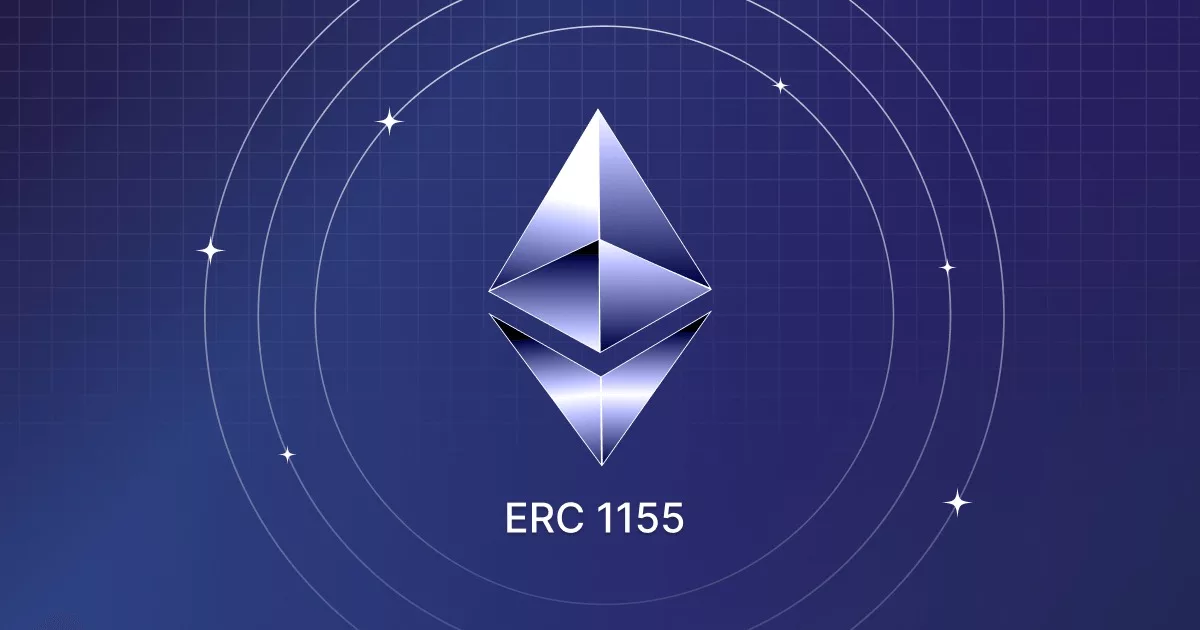
ERC-1155 enables developers to create and manage multiple types of tokens within a single, smart contract, providing efficiency, flexibility, and cost-effectiveness.
This standard has gained significant attention in the world of blockchain gaming, decentralized finance (DeFi), and other digital asset applications.
In this article, we will explore the features and benefits of ERC-1155 and its potential impact on the blockchain ecosystem.
What is ERC-1155?
ERC-1155 is a token standard on the Ethereum blockchain that allows for the creation and management of both fungible (identical and interchangeable) and non-fungible (unique and indivisible) assets.
It was proposed as an improvement over existing token standards, such as ERC-20 and ERC-721, to address their limitations and provide greater flexibility.
The key feature of ERC-1155 is its ability to support multiple token types within a single, smart contract.
Unlike previous standards that required separate contracts for each token type, ERC-1155 enables developers to create a wide range of fungible and non-fungible assets within a unified contract. This offers several advantages, including reduced gas costs and improved efficiency.
By consolidating multiple tokens under one contract, developers can save on deployment costs and simplify the management and interaction of assets.
The versatility of ERC-1155 has made it popular in the gaming industry, as it allows for the creation of in-game items and digital collectibles that can be owned, traded, and used across multiple games and platforms. It has also found applications in decentralized finance (DeFi), where it enables the creation of composite assets and complex financial instruments.
How Does ERC-1155 Work?
ERC-1155 works by implementing a smart contract on the Ethereum blockchain that defines the behavior and properties of tokens. The smart contract contains the logic and rules for creating, managing, and transferring both fungible and non-fungible assets.
At its core, ERC-1155 introduces the concept of “token IDs” to differentiate individual instances of tokens within the contract. Each token ID represents a unique asset, whether fungible or non-fungible. These token IDs serve as a way to track ownership and enable specific interactions with each token.
The smart contract maintains an internal mapping of token balances for each address, keeping track of the number of tokens owned by a particular address for each token ID. This allows for efficient querying and updating of token balances.
To transfer tokens, the contract provides functions that allow users to send tokens from one address to another. These functions handle deducting tokens from the sender’s balance and adding tokens to the recipient’s balance. This transfer process can be done individually or in batches, allowing for efficient handling of multiple tokens in a single transaction.
For non-fungible tokens (NFTs), ERC-1155 introduces the concept of token classes. Each token class represents a unique type of asset, and individual tokens within a class are identified by their token IDs. This enables the creation of multiple instances of a non-fungible asset while providing a distinct identity for each instance.
ERC-1155 also includes events and optional metadata support. Events are emitted during token transfers and other important actions, providing a way for applications to listen and respond to changes in token ownership. Metadata support allows developers to attach additional information to each token, such as names, descriptions, or external links, enhancing the usability and discoverability of tokens.
Applications of ERC-1155
ERC-1155 has found a wide range of applications across various industries.
1. Gaming Industry
ERC-1155 has gained significant traction in the gaming industry. It allows developers to create and manage in-game items, virtual collectibles, and digital assets as both fungible and non-fungible tokens.
Players can own, trade, and sell these items securely on blockchain-based marketplaces, fostering a transparent and decentralized gaming economy.
The interoperability of ERC-1155 tokens enables cross-platform compatibility, allowing players to use their assets across multiple games.
2. Decentralized Finance (DeFi)
ERC-1155 is utilized in DeFi applications for creating composite assets and complex financial instruments. It enables the creation of tokenized representations of real-world assets, such as stocks, bonds, or commodities, which can be traded on decentralized exchanges.
ERC-1155’s ability to handle multiple token types within a single contract simplifies the management of diverse financial assets in DeFi protocols.
3. Digital Art and Collectibles
ERC-1155 has been embraced by digital artists and collectors due to its support for both fungible and non-fungible assets.
Artists can tokenize their digital artwork, granting each piece a unique identity as an NFT, while also creating limited editions or prints as fungible tokens. This allows for secure ownership, provenance tracking, and fractional ownership of digital art and collectibles.
4. Tokenized Assets and Real Estate
ERC-1155 enables tokenizing real-world assets, such as real estate properties or investment funds.
By representing these assets as tokens, ownership, and transfer can be easily recorded and managed on the blockchain. This opens up opportunities for fractional ownership, increased liquidity, and global accessibility to traditionally illiquid assets.
Advantages and Challenges of ERC-1155
We will look into the advantages and challenges pertaining to ERC-1155
Advantages
Let’s start with the advantages of using ERC-1155.
1. Efficiency and Cost-effectiveness
ERC-1155 allows creating multiple token types within a smart contract, reducing deployment costs and gas fees.
Handling multiple tokens in a batch transfer improves scalability and reduces transaction costs.
2. Flexibility
ERC-1155 supports both fungible and non-fungible tokens, offering developers the ability to create diverse token ecosystems within a single contract. This flexibility enables representation of a wide range of assets and simplifies their management and interoperability.
3. Interoperability
ERC-1155 tokens can be easily integrated into various applications and platforms, promoting interoperability across the blockchain ecosystem.
They can be traded on decentralized exchanges, used as collateral in lending protocols, or incorporated into decentralized applications, enhancing their utility and value.
Challenges
Now, let us delve into the challenges associated with ERC-1155.
1. Adoption Rate
While ERC-1155 has gained significant attention and adoption, it is still relatively newer than other token standards like ERC-20 and ERC-721.
Widespread adoption and compatibility across platforms and wallets can take time.
2. Complexity
Implementing ERC-1155 requires a deeper understanding of token standards and smart contract development than simpler standards like ERC-20.
Developers must carefully manage the logic for different token types within the contract, ensuring correct handling of transfers and balances.
3. User Education
Users may need to familiarize themselves with owning and managing multiple token types within a single contract.
Educating users about the advantages and functionalities of ERC-1155 tokens is important for their wider adoption and usage.
Conclusion
ERC-1155 has emerged as a powerful token standard combining the advantages of fungible and non-fungible tokens, offering developers and users increased flexibility and efficiency.
ERC-1155 has opened up new possibilities for blockchain gaming, decentralized exchanges, and other digital asset applications by allowing multiple types of tokens to coexist within a single, smart contract. Its ability to reduce gas costs and improve scalability makes it an attractive choice for developers seeking to optimize their projects.
As the blockchain ecosystem continues to evolve, ERC-1155 is poised to play a significant role in shaping the future of tokenization and decentralized applications.
FAQs
1. What is ERC-1155, and how does it differ from other token standards?
ERC-1155 is a token standard on the Ethereum blockchain that allows for the creation and management of both fungible and non-fungible assets.
Unlike other token standards like ERC-20 and ERC-721, ERC-1155 enables developers to create multiple tokens within a smart contract. This eliminates the need for separate contracts for each token type, reducing gas costs and enhancing efficiency.
ERC-1155 also offers improved batch transfers, allowing multiple tokens to be sent in a single transaction, further enhancing scalability.
2. How is ERC-1155 utilized in the gaming industry?
ERC-1155 has found significant utilization in the gaming industry. It enables developers to create in-game items, such as weapons, armor, or virtual collectibles, as both fungible and non-fungible tokens. This makes it possible for players to own, trade, and sell these items securely on blockchain marketplaces.
ERC-1155’s efficient batch transfer functionality allows seamless and cost-effective distribution of in-game rewards or airdrops to players, enhancing the gaming experience and promoting user engagement.
3. Can ERC-1155 tokens represent both fungible and non-fungible assets?
Yes, ERC-1155 tokens can represent both fungible and non-fungible assets. Fungible tokens are identical and interchangeable, such as cryptocurrencies, while non-fungible tokens (NFTs) represent unique and indivisible assets, like digital artwork or game collectibles.
With ERC-1155, developers can create smart contracts encompassing both types of tokens, providing the flexibility to handle various asset types within a single contract. This eliminates the need for separate contracts for each token type and simplifies the management and interoperability of both fungible and non-fungible assets on the Ethereum blockchain.




